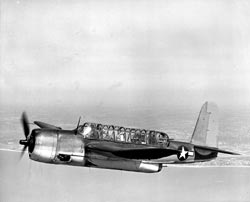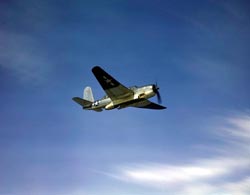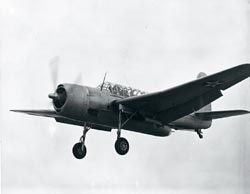|
 In 1939, the Bureau of Aeronautics sent the industry a request for proposal on a new torpedo bomber. In April 1940, the U.S. Navy contracted with Vought for a single prototype. Designated XTBU-l and named Sea Wolf, it made its first flight 2 weeks after Pearl Harbor. In 1939, the Bureau of Aeronautics sent the industry a request for proposal on a new torpedo bomber. In April 1940, the U.S. Navy contracted with Vought for a single prototype. Designated XTBU-l and named Sea Wolf, it made its first flight 2 weeks after Pearl Harbor.
A mid-wing monoplane, the three-place Sea Wolf was a large machine powered with the big 1800-hp P&W R-2800-6 engine,a wing span of 56 ft 11 in, a length of 39 ft and a height of 18 ft 7 in. Its top speed of 3ll mph made it an exceptional performer. It was well ahead of the TBF Avenger and the U.S. Navy set about to purchase 1,000 of them.
 The XTBU-1 was being flight tested at Anacostia in Washington when, during one of the arrested landings, the hook caught and tore the whole rear end off the airplane. The airplane went bouncing down the runway on just the wheels and forward portion of the fuselage. The two sections were returned to Stratford and on an expedited basis, the Experimental Department worked day and night for four solid weeks to rebuild the tail section. The day they finished, they were pushing it back across the street to the hangar when a Navy cadet lost control of his plane while taxiing in the same area. Everybody scattered as the careening trainer slammed into the rear of the XTBU-1, completely chewing up the tail that everybody had worked so hard to rebuild. If anybody came close to a lynching, it was that poor cadet. The XTBU-1 was being flight tested at Anacostia in Washington when, during one of the arrested landings, the hook caught and tore the whole rear end off the airplane. The airplane went bouncing down the runway on just the wheels and forward portion of the fuselage. The two sections were returned to Stratford and on an expedited basis, the Experimental Department worked day and night for four solid weeks to rebuild the tail section. The day they finished, they were pushing it back across the street to the hangar when a Navy cadet lost control of his plane while taxiing in the same area. Everybody scattered as the careening trainer slammed into the rear of the XTBU-1, completely chewing up the tail that everybody had worked so hard to rebuild. If anybody came close to a lynching, it was that poor cadet.
 Rebuilt again, the XTBU-1 was finally accepted by the U.S. Navy and a production contract was forthcoming. Vought was heavily committed to meet schedules on their other aircraft and arrangements were made with Consolidated-Vultee of Allentown, PA, to produce the TBU as the TBY. The first production TBY-2, as the production planes were designated, was delivered in November 1944. One hundred eighty-nine were built before the contract was canceled. Initially, the TBY-2 was issued to at least two squadrons. The squadrons were training for deployment as the war was drawing to a close. The TBY-2’s were withdrawn, however, and the squadron equipped with TBMs as it was felt there were still so many bugs in the aircraft that could not be worked out before the deployment date. Thereafter, the TBY-2’s were used in a utility configuration at various bases. Some TBY-2’s were assigned to Reserve squadrons. Rebuilt again, the XTBU-1 was finally accepted by the U.S. Navy and a production contract was forthcoming. Vought was heavily committed to meet schedules on their other aircraft and arrangements were made with Consolidated-Vultee of Allentown, PA, to produce the TBU as the TBY. The first production TBY-2, as the production planes were designated, was delivered in November 1944. One hundred eighty-nine were built before the contract was canceled. Initially, the TBY-2 was issued to at least two squadrons. The squadrons were training for deployment as the war was drawing to a close. The TBY-2’s were withdrawn, however, and the squadron equipped with TBMs as it was felt there were still so many bugs in the aircraft that could not be worked out before the deployment date. Thereafter, the TBY-2’s were used in a utility configuration at various bases. Some TBY-2’s were assigned to Reserve squadrons.
|